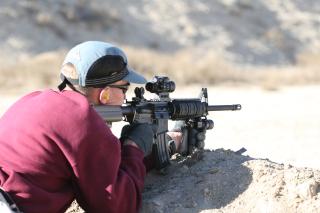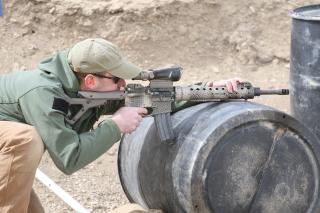
 # 1. # 1. The Aimpoint is the most common Type I optic- durable, long battery life, reliable.
There are two dominant Type I optics: the Aimpoint and the EOTech. The Aimpoint M2, M3, and M4 have
much, much longer battery life than the EOTech. The Aimpoints also can be powered up and "verified
on" by touch only, without looking at the reticle. The drill for turning on an EOTech is to hit the
"on" button and keep hitting it while looking at the reticle until it's bright enough. Market price
for either of these optics including a quick-release mount is $500-800.
There are a couple "3x" magnifier units now becoming available which can be mounted just behind an
Aimpoint or EOTech, yet be quickly flipped out of the way when not needed. These can help with
target ID, however, they have a much narrower field of view than true magnified optics (Type II and
III).
Type II: low-power magnified optics with reticle features for bullet-drop compensation when engaging
targets outside of the cartridge's point-blank range. External and non-capped target knobs/turrets
should be avoided to ensure the zero is not lost when the knobs get bumped, hit, or rub on other
gear. Type II optics are designed for quickly engaging targets from about 75 yards out to about 400
yards. Many Type II optics are fixed magnification at 3.5x or 4x, however, several variable power 1
- 4x scopes are also in use. The most common is the Trijicon ACOG: 4x (TA31, TA01) or 3.5x (TA11).
The US Military realizes many of these needs in the Designated Marksman Rifle (DMR) and Squad
Designated Marksman Rifle (SDM-R).

 # 2. # 2. The Trijicon TA11 ACOG is a compact and durable Type II optic optimized for quickly engaging
multiple targets from 75 to 400 yards.
At CQB distances, most Type II optics are a liability-- slower to acquire a sight picture than Type
I red dots sights. The Type II optics can be used past 400 yards, however, targets must be large
and the shooter will have to pay close attention to his particular weapon and ammunition's
performance when using the reticle BDC. These optics provide good target spotting and ID
capabilities. Close-range performance can be improved if the optic provides a very bright center
illumination such as Trijicon's fiber-optic-lit "donut", taking advantage of the brains attraction
to bright objects. Besides the fixed-power ACOGs, a low-variable-power Type II optic will improve
close-range speed, giving close to 1x red dot acquisition speed, but the ability to crank up the
power for target ID and longer shots.
Of the fixed-power Type II optics, the TA11 ACOG is the best choice. It provides a little more eye
relief and a large exit pupil than the TA01 and TA31. Together, these two attributes make it a lot
faster to acquire a sight picture and easier to maintain while on the move. The 0.5x difference in
magnification versus the TA31 is marginal. Price on a TA31 or TA11 ACOG with a QR mount is about a
grand. The Schmidt and Bender 1.1-4x20mm Short Dot has almost true 1x at the low and a bright
illuminated reticle center. It has a mil-based reticle for bullet drop, in addition to external
target knobs (the locking turrets are the way to go for reliability). The extra capability of the
Short Dot is paid for in bulk and its $2200 ticket. The sleeper is the 1.25-4x24mm Trijicon
AccuPoint (TR21). It shares the same fiber-optic design as the TA31/TA11, but can be dialed down to
low power for close-range work. Its reticle has no BDC features, however. The TR21 is a good deal
at about $575.
|